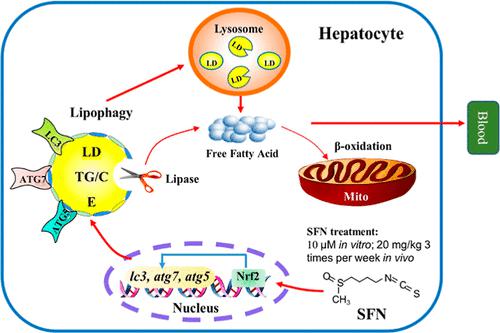当前位置:
X-MOL 学术
›
J. Agric. Food Chem.
›
论文详情
Our official English website, www.x-mol.net, welcomes your
feedback! (Note: you will need to create a separate account there.)
Sulforaphane Ameliorates Hepatic Lipid Metabolism via Modulating Lipophagy In Vivo and In Vitro
Journal of Agricultural and Food Chemistry ( IF 5.7 ) Pub Date : 2022-11-24 , DOI: 10.1021/acs.jafc.2c06311 Peng Lei 1, 2 , Yunqi Hu 1 , Peng Gao 2 , Qi Ding 1 , Jielin Yan 1 , Jiahe Zhao 3 , Baolong Li 3 , Yujuan Shan 1
Journal of Agricultural and Food Chemistry ( IF 5.7 ) Pub Date : 2022-11-24 , DOI: 10.1021/acs.jafc.2c06311 Peng Lei 1, 2 , Yunqi Hu 1 , Peng Gao 2 , Qi Ding 1 , Jielin Yan 1 , Jiahe Zhao 3 , Baolong Li 3 , Yujuan Shan 1
Affiliation

|
Although sulforaphane (SFN) is reported to ameliorate the excessive accumulation of lipid droplets (LDs) in hepatocytes, its underlying mechanism remains unclear. This paper aims to investigate how SFN induces hepatic LD degradation via activating macroautophagy. High-fat diet and free fatty acids (FFAs) were used to induce excessive LD formation in hepatocytes in vivo and in vitro, respectively. SFN-induced macroautophagy was shown by the increased LC3 protein expression both (1.32 ± 0.18) in vivo and (2.43 ± 0.22) in vitro. The mRNA levels of Lc3 (1.99 ± 0.16), Atg4 (2.12 ± 0.23), Ulk1 (1.19 ± 0.12), Atg7 (1.25 ± 0.11), and Atg5 (0.81 ± 0.1) genes were elevated by SFN. SFN individually enhanced the localization of LC3 (0.41 ± 0.15), LAMP1 (0.66 ± 0.14), ATG7 (0.26 ± 0.08), and ATG5 (0.38 ± 0.09) with LDs, indicating the occurrence of lipophagy. In the components of LDs isolated from SFN treatment, the expressions of LC3, ATG7, and ATG5 protein were largely increased both in vivo and in vitro. LDs were visualized in autophagosomes which confirmed that the lipophagy was triggered by SFN. Moreover, SFN treatment improved the profile of FFAs which was characterized by increasing the FFAs in liver (total FFA: 261.51 ± 39.58 μM/g) and serum (total FFA: 967.59 ± 239.18 nM/mL). After silencing the nrf2 gene, ATG7 and ATG5 protein expressions were decreased and attenuated this induction by SFN. Nrf2 gene silencing inversely increased TG contents. In summary, SFN enhanced the LD degradation via stimulating lipophagy in a Nrf2-dependent manner.
中文翻译:

萝卜硫素通过调节体内和体外的脂肪吞噬作用改善肝脏脂质代谢
尽管据报道萝卜硫素 (SFN) 可改善肝细胞中脂滴 (LD) 的过度积累,但其潜在机制仍不清楚。本文旨在研究 SFN 如何通过激活巨自噬诱导肝脏 LD 降解。高脂肪饮食和游离脂肪酸 (FFA) 分别用于在体内和体外诱导肝细胞中过度的 LD 形成。SFN 诱导的巨自噬表现为体内 LC3 蛋白表达增加 (1.32 ± 0.18) 和体外 (2.43 ± 0.22)。Lc3 (1.99 ± 0.16)、Atg4 (2.12 ± 0.23)、Ulk1 (1.19 ± 0.12)、Atg7 (1.25 ± 0.11) 和Atg5的 mRNA 水平(0.81 ± 0.1) 基因被 SFN 升高。SFN 单独增强了 LC3 (0.41 ± 0.15)、LAMP1 (0.66 ± 0.14)、ATG7 (0.26 ± 0.08) 和 ATG5 (0.38 ± 0.09) 与 LD 的定位,表明发生了脂肪吞噬。在从 SFN 处理分离的 LD 的成分中,LC3、ATG7 和 ATG5 蛋白的表达在体内和体外都大大增加。LDs 在自噬体中可视化,这证实了 SFN 触发了脂肪吞噬。此外,SFN 治疗改善了 FFA 的特征,其特征是增加了肝脏(总 FFA:261.51 ± 39.58 μM/g)和血清(总 FFA:967.59 ± 239.18 nM/mL)中的 FFA。使nrf2沉默后基因、ATG7 和 ATG5 蛋白表达降低并减弱了 SFN 的这种诱导。Nrf2 基因沉默会反向增加 TG 含量。总之,SFN 通过以 Nrf2 依赖性方式刺激脂肪吞噬来增强 LD 降解。
更新日期:2022-11-24
中文翻译:

萝卜硫素通过调节体内和体外的脂肪吞噬作用改善肝脏脂质代谢
尽管据报道萝卜硫素 (SFN) 可改善肝细胞中脂滴 (LD) 的过度积累,但其潜在机制仍不清楚。本文旨在研究 SFN 如何通过激活巨自噬诱导肝脏 LD 降解。高脂肪饮食和游离脂肪酸 (FFA) 分别用于在体内和体外诱导肝细胞中过度的 LD 形成。SFN 诱导的巨自噬表现为体内 LC3 蛋白表达增加 (1.32 ± 0.18) 和体外 (2.43 ± 0.22)。Lc3 (1.99 ± 0.16)、Atg4 (2.12 ± 0.23)、Ulk1 (1.19 ± 0.12)、Atg7 (1.25 ± 0.11) 和Atg5的 mRNA 水平(0.81 ± 0.1) 基因被 SFN 升高。SFN 单独增强了 LC3 (0.41 ± 0.15)、LAMP1 (0.66 ± 0.14)、ATG7 (0.26 ± 0.08) 和 ATG5 (0.38 ± 0.09) 与 LD 的定位,表明发生了脂肪吞噬。在从 SFN 处理分离的 LD 的成分中,LC3、ATG7 和 ATG5 蛋白的表达在体内和体外都大大增加。LDs 在自噬体中可视化,这证实了 SFN 触发了脂肪吞噬。此外,SFN 治疗改善了 FFA 的特征,其特征是增加了肝脏(总 FFA:261.51 ± 39.58 μM/g)和血清(总 FFA:967.59 ± 239.18 nM/mL)中的 FFA。使nrf2沉默后基因、ATG7 和 ATG5 蛋白表达降低并减弱了 SFN 的这种诱导。Nrf2 基因沉默会反向增加 TG 含量。总之,SFN 通过以 Nrf2 依赖性方式刺激脂肪吞噬来增强 LD 降解。































 京公网安备 11010802027423号
京公网安备 11010802027423号